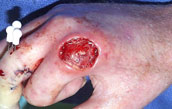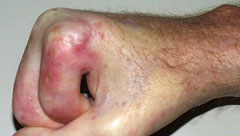
|
A 43-year-old man developed multiple
complications of rapidly progressive scleroderma.
His hands had skin atrophy, sclerosis, and telangiectasias
typical of scleroderma. There were multiple contractures
and skin lesions. The largest ulcer was on the dorsum
of the index finger metacarpophalangeal joint, where
loss of the dorsal joint capsule caused direct wide
exposure of the joint space and dorsal bone surfaces.
As one of the few fingers not contracted and still
functional, salvage was important for rudimentary
activities. This view, in surgery, shows the open
metacarpophalangeal joint and degenerated bone at
the base of the phalanx.
|
 |


|
These open structures required
suitable coverage. Sclerotic skin made local flaps
a technical impossibility. Histology showed stenotic
fibrotic arteries typical of immunopathic angiopathy,
and impaired circulation made any surgery risky.
Conventional options for closure, including topical
care, repair, flaps, grafts, and amputation, were
all too risky, doomed to fail, technically unfeasible,
or too destructive of remaining function. Only Integra
offered a safe, dependable, sensible solution.
|
 |
|
Integra healed the open bones
and joint and preserved a functioning finger, shown
here at 6 months. The material is compliant enough
to allow full flexion. Threats to the finger are
gone, and daily function is possible.
|
 |
Cases Courtesy of:
Marc E. Gottlieb, M.D., Jennifer Furman
Journal of Burns and Wounds, Vol 3, #2